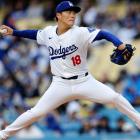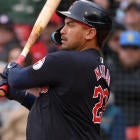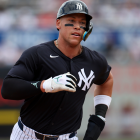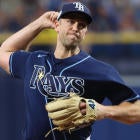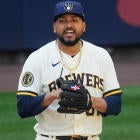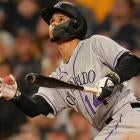These strategies apply specifically to Head-to-Head leagues. For Rotisserie strategies or auction strategies, check out the guides specific to those formats.
Rotisserie play has kind of spoiled the Fantasy Baseball world. It's slow and leisurely, a hands-off approach to playing. You draft your team and watch it cook like a chicken on a spit, turning and turning until it's golden brown. You can measure its progress along the way, of course, taking a peak through the glass to make sure all the ingredients are coming together, but only the finished product counts. Only then do you declare it a success or failure.
In Head-to-Head play, the losing doesn't just happen at the end. It happens with each matchup along the way, attaching greater permanence to in-season roster management.
You can't just say, "Oh, I'll leave that injured superstar in my lineup just in case he comes back next week. I can always make up for it later." Nuh-uh. That loss never goes away. There is no making up for it later.
Granted, you can take more than a few losses and still make the playoffs, but if you blow it too many times, you're out -- no matter how good your roster may be.
You wonder how a team can lead the league in scoring and still have a losing record? That's how.
Because of the increased accountability, because every decision demands a higher level of scrutiny, shouldn't you approach Draft Day with a little more caution? Shouldn't you choose your players with a little more care, avoiding the ones at risk for uneven performances? They may offer attractive potential, maybe even attractive numbers, but if they continually stick you with losses because of untimely slumps, injuries or absences, what good are they?
Performance only half the battle
Chances are before coming here, you checked out our player rankings, as you well should. They're the focus of all analysis and the primary tool by which everyone drafts.
But rankings have their limitations: They only account for the endgame. They take a player, plug his projected stats into a formula, and spit him out wherever his score dictates. They don't consider the distribution of that score over an entire season.
Sometimes the next player on the list isn't necessarily the best one for you.
Remember Chipper Jones? He's a different player now, but just a couple years ago, his percentages ranked right up there with anybody's, including Albert Pujols'.
But for Fantasy purposes -- or Head-to-Head purposes, anyway -- it didn't mean a whole lot because he could never play more than 125 games or so.
Maybe that doesn't seem like a big deal to you. Maybe you say you can find an adequate replacement when he's injured and still get the benefit of his sky-high production when he's healthy -- which is still more often than not -- and in theory, you're right. But it's never that simple. You don't always know when he'll get injured or how long he'll be injured. If he sprains his ankle on a Saturday afternoon and goes on the DL the next day, great, you can just bench him. But if he sprains it on a Tuesday -- one day after your league's lineup deadline -- then you have no choice but to take zeroes from his lineup spot for the rest of the week. And unless someone else steps up and has a huge week, that's usually going to mean a loss.
Even worse, let's say he doesn't sprain his ankle but just "tweaks" it. He misses a game. He misses another. Another and another. He won't go on the DL because his ankle could feel better any day now, but he won't give an exact timetable for his return either. What do you do? If you start him, you risk getting a week of zeroes from him and, most likely, a loss, but if you sit him, you risk not getting a full return on your investment.
For players with the Chipper Jones label -- guys like Kevin Youkilis, Aramis Ramirez, Nelson Cruz and, in recent years, Alex Rodriguez -- you face this dilemma every other week. They may not actually miss half the season due to injuries, but you end up sitting them half the season because you never know which injury will be the injury that puts them out.
That's not to say you should totally ignore such players -- eventually, every player reaches a point when the value justifies the risk -- but you have to downgrade them in a way the rankings can't.
You could take the process one step further and downgrade streaky players as well, but streakiness is one of those unmeasurable qualities that, in all but a few extreme cases, is susceptible to faulty perception. Still, as a general rule, players who walk more streak less. Eyes don't slump, and as long as a player gets on base, he has an opportunity to score Fantasy points.
Plus, unlike in Rotisserie leagues, those walks count for something in and of themselves.
Winning on peripherals
That's right: Walks count, as do doubles, triples and all those other stats that go overlooked in Rotisserie leagues.
And when something goes overlooked, you can usually use it to your advantage.
Winning on peripherals, I call it. With us Fantasy owners trained to think of batting averages, home runs and stolen bases as the end-all, be-all for hitters, the less-heralded stats allow less-heralded players to sneak up in the rankings. They score points whether anybody knows it or not.
Just go to "Custom Reports" in a standard Head-to-Head league and sort by last year's numbers. Bet you didn't know Billy Butler scored the same number of points as Ryan Zimmerman. And who would have guessed Nick Markakis outscored Matt Kemp when he had fewer home runs, stolen bases, RBI and runs scored? The numbers don't add up.
But that's because you didn't include all the numbers. Markakis had 20 more doubles, 20 more walks and 77 fewer strikeouts than Kemp, leading to 16.5 more of the sneakiest Fantasy points you'll ever see.
Scroll down the list, and player after player should pop out at you. Bobby Abreu over Corey Hart. Derek Jeter over Adam Dunn. Daric Barton over Drew Stubbs. It's madness.
Nope, it's Head-to-Head scoring, and it's open for exploitation year after year.
The process is simple enough. All you do is plug last year's numbers into your scoring format, pick out anything that looks weird and figure out why. You don't have to treat it as gospel or anything. You don't have to draft Barton over Stubbs just because he outscored him last year. In fact, you wouldn't want to, if for no other reason than because you'd have no competition for him that early.
But knowing he actually outscored Stubbs last year should make him more attractive in your eyes. If you can pick out those format-specific sleepers and target them at the appropriate times, you'll get all the upside of a Kemp or Stubbs and the assured points of a Markakis or Barton.
The point isn't to have some oddball draft that puts you in a different stratosphere from the rest of the league. The point is to scope out the inefficiencies in perception, to familiarize yourself with your scoring format in a way most people never take the time to do.
It's the easiest and most objective way to gain an advantage.
Resisting the itching for pitching
Of course, those inefficiencies aren't so obvious among pitchers, whose stats have a more direct correlation between Head-to-Head and Rotisserie.
But the position isn't without its quirks. In fact, you could write the whole thing off as an inefficiency given the way people prioritize it on Draft Day, subscribing to the widespread belief that pitching trumps hitting in Head-to-Head leagues.
No doubt, it deserves more emphasis than in Rotisserie leagues, where wins and innings don't carry quite as much weight, but that subtle difference shouldn't rock the foundation of longstanding Fantasy ideology.
So what's the justification? Pitchers score more points than hitters in Head-to-Head leagues. It's a fact. All you need to do is look at last year's numbers to know it. Of the nine players who scored more than 600 points last year, five were pitchers. End of story.
But that's true for pitchers all the way down the line. Just like the first pitcher will outscore the first second baseman, the 10th pitcher will outscore the 10th second baseman. Shoot, the 50th pitcher will outscore the 10th second baseman, as happened last year with John Lackey and Juan Uribe. You don't lose the advantage of the position just by settling for a lesser option at the position.
A player's value in Fantasy is relative to the other players at his same position, not the other players at other positions. That's why Hanley Ramirez regularly goes off the board before Joey Votto and Mark Teixeira even though he's unlikely to score as many points. The people who draft him want to make sure they lock up one of the few elite shortstops because the drop-off at the position is so extreme. Yes, Votto alone may outscore Ramirez alone, but the combination of Ramirez in the first round and Kendry Morales in the seventh is projected for a higher score (1,068.5 Fantasy points) than Votto in the first round and Elvis Andrus in the seventh (999.5). It's common knowledge.
So why is it any different for pitchers? Why is the concept so hard to grasp? It's caught on in Fantasy Football. Quarterbacks typically outscore running backs, but you won't find anyone telling you to pick them instead.
Everyone has to start the same number of pitchers just like everyone has to start the same number of second basemen or quarterbacks. Drafting one earlier doesn't give you a free pass to start him somewhere else. Your focus, therefore, shouldn't be on where you can get the most points at the time you pick, but on where can you get the biggest advantage. More often than not, it's with the position players.
Even if you understand the concept of relative production and still think you need a staff of elite pitchers, drafting one early won't assure you of that. Hitters are generally safer early-round investments because they don't come with the same injury risks as pitchers. And considering how many aces rise out of the middle and late rounds every year -- who was drafting Mat Latos, Trevor Cahill and Brett Myers at this time last year? -- you don't stand to lose as much by waiting at the position.
And it goes one step further in Head-to-Head leagues. In order to maximize your output and give yourself the best chance of winning each week, you'll want to make full use of two-start pitchers. Having an extra start or two each week, which you can accomplish simply by carrying more pitchers on your bench, will help compensate for any shortcomings of your pitching staff. Hitters don't have a similar type of workaround.
Of course, to take advantage of that workaround, you'll have to make adequate use of your reserve slots.
Bench is no place for backups
Yes, I understand the temptation to handle your bench like a major-league team would, stashing a backup catcher here, a utility infielder there and whatever else you'd need to reinforce every position across the diamond.
But you don't have the same concerns as a major-league team. It has to contend with in-game substitutions and a bare free-agent market. You have a weekly lineup deadline and a waiver wire that more than likely houses one or two All-Stars.
To a certain degree, you can think of the waiver wire as an extension of your roster. Through it, you will always have serviceable everyday players at your disposal. They aren't going anywhere. Nobody in your league will decide to snatch up the 10 available second basemen one day, leaving you without a viable replacement. If you end up needing one, you can always get one.
If you play in a league so deep that your waiver wire has nothing to offer but Gregg Zaun and Andy Marte, then you might have reason to protect your starters. But most people don't play in leagues that deep. Most have plenty of alternatives at their disposal.
Reserve spots are precious. You want to save them for the players you absolutely have to protect -- the ones who wouldn't last a day on the waiver wire because they'd most likely be starting for any other team.
So instead of using your reserve spots on backups you don't have any reason to protect, use them on pitchers instead. Draft as many high-upside types as you can because the more breakout candidates you have, the more two-start options you'll have.
And the more two-start options you have, the more of an advantage you'll have at the position even if you didn't target it early.
You can have hitters on your bench, but only if they offer enough upside to become must-start Fantasy options themselves. And you wouldn't want to have too many. Chances are you won't need them as much as the pitchers, particularly if you stuck to drafting hitters in the early rounds instead of getting caught up in the rush for aces.
It seems like such a trivial detail -- how you construct your bench in Fantasy -- but it's just another reminder that the game isn't all about picking the best players. It's about winning, and if you're familiar with your league's rules and scoring format, you can make the most of its inefficiencies and workarounds and ensure a higher chance of success.
And in Head-to-Head leagues, where any given week, any little misstep could take you another step out of the playoff picture, it's all the more worthwhile.
Stay in touch with the most passionate Fantasy staff in the business by following us via Twitter . You can e-mail us your Fantasy Baseball questions to DMFantasyBaseball@cbs.com . Be sure to put Head-to-Head Strategies in the subject field. Please include your full name, hometown and state.













